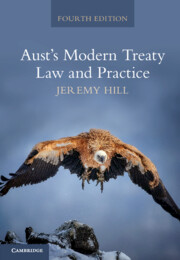Refine search
Actions for selected content:
36807 results in Cambridge Textbooks
Appendices
-
- Book:
- The Atmospheric General Circulation
- Published online:
- 26 May 2023
- Print publication:
- 20 April 2023, pp 362-382
-
- Chapter
- Export citation
3 - The Institutional Framework
- from Part I - Setting the Scene: Origins, Analytical Perspectives and Institutions
-
- Book:
- The Politics of the European Union
- Published online:
- 30 March 2023
- Print publication:
- 20 April 2023, pp 46-72
-
- Chapter
- Export citation
Abbreviations
-
- Book:
- Beginning Syntax
- Published online:
- 23 March 2023
- Print publication:
- 20 April 2023, pp xv-xvi
-
- Chapter
- Export citation
Appendix A - Space and Time Averaging Operations
-
- Book:
- The Atmospheric General Circulation
- Published online:
- 26 May 2023
- Print publication:
- 20 April 2023, pp 362-364
-
- Chapter
- Export citation
Part II - Key Actors in EU Politics: Citizens, Interest Groups and Political Parties
-
- Book:
- The Politics of the European Union
- Published online:
- 30 March 2023
- Print publication:
- 20 April 2023, pp 101-164
-
- Chapter
- Export citation
Controversies
-
- Book:
- The Politics of the European Union
- Published online:
- 30 March 2023
- Print publication:
- 20 April 2023, pp xviii-xviii
-
- Chapter
- Export citation
2 - Analysing the EU
- from Part I - Setting the Scene: Origins, Analytical Perspectives and Institutions
-
- Book:
- The Politics of the European Union
- Published online:
- 30 March 2023
- Print publication:
- 20 April 2023, pp 28-45
-
- Chapter
- Export citation
Index
-
- Book:
- Beginning Syntax
- Published online:
- 23 March 2023
- Print publication:
- 20 April 2023, pp 234-239
-
- Chapter
- Export citation
12 - The High Frequency Extratropical Transients
- from Part V - The Zonally Varying Extratropical Tropospheric Circulation
-
- Book:
- The Atmospheric General Circulation
- Published online:
- 26 May 2023
- Print publication:
- 20 April 2023, pp 214-228
-
- Chapter
- Export citation
9 - The Global Stratospheric Circulation
- from Part IV - The Stratospheric General Circulation
-
- Book:
- The Atmospheric General Circulation
- Published online:
- 26 May 2023
- Print publication:
- 20 April 2023, pp 157-171
-
- Chapter
- Export citation
10 - Decision-Making
- from Part III - EU Policies: Agenda-Setting, Decision-Making and Implementation
-
- Book:
- The Politics of the European Union
- Published online:
- 30 March 2023
- Print publication:
- 20 April 2023, pp 215-237
-
- Chapter
- Export citation
21 - Diurnal and Higher Frequency Variability of the Global Circulation
- from Part VI - The Tropical General Circulation
-
- Book:
- The Atmospheric General Circulation
- Published online:
- 26 May 2023
- Print publication:
- 20 April 2023, pp 353-361
-
- Chapter
- Export citation
6 - Binding
-
- Book:
- Beginning Syntax
- Published online:
- 23 March 2023
- Print publication:
- 20 April 2023, pp 130-155
-
- Chapter
- Export citation
7 - Syntax beyond English
-
- Book:
- Beginning Syntax
- Published online:
- 23 March 2023
- Print publication:
- 20 April 2023, pp 156-178
-
- Chapter
- Export citation
19 - Day-to-Day Variability of the Tropical Circulation
- from Part VI - The Tropical General Circulation
-
-
- Book:
- The Atmospheric General Circulation
- Published online:
- 26 May 2023
- Print publication:
- 20 April 2023, pp 330-343
-
- Chapter
- Export citation
Index
-
- Book:
- The Atmospheric General Circulation
- Published online:
- 26 May 2023
- Print publication:
- 20 April 2023, pp 395-406
-
- Chapter
- Export citation
Part II - Balance Requirements for the General Circulation
-
- Book:
- The Atmospheric General Circulation
- Published online:
- 26 May 2023
- Print publication:
- 20 April 2023, pp 55-118
-
- Chapter
- Export citation
Part IV - The Stratospheric General Circulation
-
- Book:
- The Atmospheric General Circulation
- Published online:
- 26 May 2023
- Print publication:
- 20 April 2023, pp 155-190
-
- Chapter
- Export citation

Keys to Academic English
-
- Published online:
- 17 April 2023
- Print publication:
- 11 April 2023
-
- Textbook
- Export citation

Aust's Modern Treaty Law and Practice
-
- Published online:
- 13 April 2023
- Print publication:
- 06 April 2023
-
- Textbook
- Export citation
